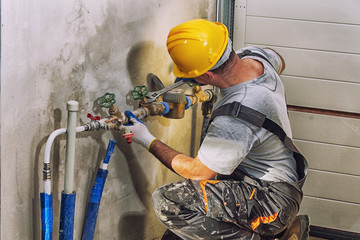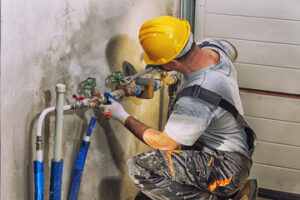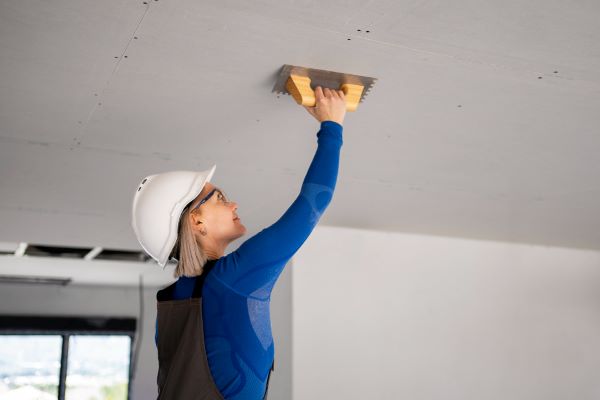Polished concrete is becoming a popular choice for modern flooring solutions. Its sleek finish and durability make it ideal for both residential and commercial spaces.
The process involves grinding, honing, and polishing concrete surfaces to achieve a smooth, reflective finish. This method enhances the natural look of concrete while increasing its strength and longevity. Visit Website to learn more.
The polishing process starts with preparing the surface. Any existing coatings, stains, or imperfections must be removed. Grinding machines with diamond segments smooth out rough areas. This creates a clean base for the polishing process.
After grinding, the surface is treated with a hardener. The hardener strengthens the concrete and increases its resistance to damage. This step also helps reduce dusting and improves the final shine. A denser surface ensures better polish retention.
Polishing involves using progressively finer grits of diamond pads. Each pass increases the smoothness and reflectivity of the surface. The final polish determines the level of glossiness. Higher grits produce a mirror-like shine.
Polished concrete is highly durable. It withstands heavy foot traffic and resists scratches and stains. Its strength makes it ideal for high-traffic areas. The surface maintains its finish for years with minimal maintenance.
Moisture resistance is another benefit of polished concrete. The densified surface prevents water from penetrating the material. This reduces the risk of mold, mildew, and water damage. It also makes cleaning easier.
Polished concrete is easy to maintain. Routine sweeping and occasional mopping keep it looking new. Its smooth surface prevents dirt and grime from embedding. A neutral cleaner preserves the shine without damaging the surface.
Stains are less likely to penetrate polished concrete. The hardening process closes the pores in the concrete. This prevents liquids and oils from soaking in. Quick cleanup of spills ensures the surface remains stain-free.
Polished concrete reflects light effectively. This enhances the brightness of any room without additional lighting. Increased light reflection reduces energy consumption. A well-lit space feels more inviting and spacious.
The versatility of polished concrete makes it suitable for various styles. It complements both industrial and minimalist designs. Decorative options include staining, scoring, and adding aggregates. Customization allows for unique finishes and textures.
Polished concrete is environmentally friendly. It uses existing concrete slabs, reducing the need for additional materials. The polishing process emits low levels of volatile organic compounds (VOCs). Its longevity reduces material waste over time.
Temperature regulation is another advantage of polished concrete. Concrete absorbs and retains heat, helping maintain a stable indoor climate. It reduces the need for heating and cooling. This contributes to energy efficiency.
Slip resistance can be enhanced with surface treatments. While polished concrete appears slick, additives increase traction. Matte finishes also provide better grip. Safety features make it suitable for residential and commercial use.
Cost-effectiveness makes polished concrete an attractive option. Installation costs are lower compared to other flooring options. Its durability reduces the need for repairs and replacements. Long-term savings make it a practical investment.
Polished concrete adapts well to underfloor heating systems. Its thermal conductivity improves heat distribution. This enhances comfort and energy efficiency. The combination of polished concrete and heating creates a warm, inviting space.
Color options are available through staining and dyes. Acid stains create a natural, marbled effect. Water-based dyes offer vibrant, consistent tones. Multiple color layers create depth and dimension.
Concrete polishing can incorporate embedded materials. Glass, metal, and stone add texture and visual interest. Aggregates are exposed during grinding. The result is a unique, decorative finish.
Polished concrete resists fading over time. UV exposure does not affect the color or finish. This makes it suitable for outdoor and indoor use. Its appearance remains consistent despite sun exposure.
High-gloss finishes enhance the modern appeal of polished concrete. The reflective surface creates a sleek, contemporary look. Matte finishes provide a softer, more natural appearance. Finish options allow for design flexibility.
Concrete overlays can be polished to improve existing floors. Overlays provide a fresh surface for polishing. They correct imperfections and unevenness. This option revitalizes old or damaged concrete floors.
Polished concrete integrates well with radiant floor heating. Its conductivity maximizes heat distribution. Even heating improves comfort during colder months. The combination enhances energy efficiency.
Joint and crack filling is part of the polishing process. Flexible sealants prevent water and debris from entering cracks. Filling joints maintains the integrity of the surface. This step improves the overall appearance and performance.
Decorative scoring adds visual interest to polished concrete. Geometric patterns and borders create custom designs. Scoring is done before polishing to integrate with the final finish. The result is a cohesive, artistic look.
Concrete polishing enhances indoor air quality. The smooth surface prevents dust and allergens from accumulating. It does not harbor mold or bacteria. A polished floor contributes to a healthier indoor environment.
Polished concrete is resistant to chemicals and oils. Industrial settings benefit from its resilience. Sealing options increase resistance to harsh substances. This makes it suitable for garages and workshops.
Acid-etched finishes create a textured surface. This enhances slip resistance while maintaining a polished look. Acid etching highlights the natural variations in the concrete. The result is a subtle, organic pattern.
Polished concrete is ideal for large spaces. Its seamless finish creates a clean, open feel. Fewer joints reduce the risk of cracking. The continuous surface enhances the overall aesthetic.
Concrete polishing minimizes surface imperfections. The grinding process removes bumps and uneven areas. Small cracks and holes are filled and sealed. The result is a flawless, smooth finish.
Polished concrete can be enhanced with metallic coatings. Reflective particles create a shimmering effect. This adds depth and visual interest. Metallic finishes elevate the modern appeal of the surface.
Moisture barriers can be applied before polishing. This prevents water from seeping through the concrete. A moisture-resistant base protects the surface. It also improves long-term performance.
Polished concrete holds up well under heavy loads. It resists cracking and chipping from heavy furniture and equipment. Its strength makes it suitable for industrial and commercial use. The surface remains stable even under pressure.
Concrete polishing is a long-term investment. Its durability reduces replacement costs. Minimal maintenance lowers upkeep expenses. The initial investment pays off through extended lifespan and performance.
Polished concrete supports creative design options. Stencils and patterns create custom logos and graphics. Epoxy inlays add color and detail. Personalization enhances the aesthetic value of the floor.
Concrete polishing adapts to changing design trends. Neutral tones and reflective surfaces complement various styles. New stains and coatings refresh the look over time. The flexibility makes it suitable for evolving spaces.
Polished concrete installation requires professional expertise. Proper grinding and polishing techniques determine the final quality. Experienced contractors ensure consistent finishes. Skilled workmanship guarantees a long-lasting result.
Polished concrete creates a modern, high-end appearance. Its sleek, reflective surface enhances any space. The combination of strength and style makes it versatile. A polished concrete floor adds value and sophistication.














